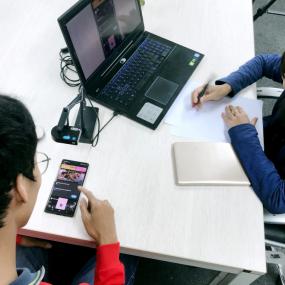User testing is an important step in the development of a website or app. It allows you to put a prototype or beta version in front of the people who will use it, observe them and learn from the results. The goal is to see if it meets user needs so that you, as the owner, manager, designer or developer, can improve it.
Testing Types
User testing vs usability testing
- User testing and usability testing are often used interchangeably but are actually slightly different. User testing happens earlier and is usually about establishing what people need from your site early on, when you may have an idea or an early prototype and you want to see if you are on track.
- Usability testing happens later when there’s a live or usable version of the site or app under development. It tests interactions in detail to make sure it does what it’s supposed to do.
Guerilla testing
- Guerilla testing is a good option for anyone developing a website or app with limited time or resources. It combines user testing and usability testing and can happen at any point in development. It’s quicker and rougher than other methods, but you will still get useful findings from a minimal investment of time and money, whether you are at early prototype stage, or you already have a live website.
This article tells you how undertake “guerilla” testing.
Why should we do user testing?
As the creator or owner, it’s very easy to lose sight of the needs of your customers, clients, or community's needs. You are far too close to it to look at it objectively and to know for sure whether it works in the way you hoped. Which means you could spend a whole lot of time and money building a website or app that will fall short, compromising the return on investment for your organisation.
Testing can reveal issues with:
- Content and layout– do people scroll through the image gallery like you hoped? Do they see the banners and buttons and interact with them as planned? Are your headlines and calls to action clear and engaging?
- Navigation – you might have put volunteer info under a menu item called “Careers” but perhaps your audience would never look there to find it. And it’s interesting to see how people problem-solve from there – do they search for it? Or do they give up?
- Technical issues – perhaps users can’t click your phone number to call it from their mobile, and you wonder why no one calls. Testing can also pick up broken links, browser issues and other bugs that UAT testing might have missed here too.
How to implement user testing yourself
1. Establish the ten or so main tasks people will need to carry out on the site for example:
- Can they find your contact details or fill in and submit the contact form easily?
- Can they go through the donation process without a hitch?
- If they are looking to work or volunteer with you, can they find what they need and understand how to register?
- If they want to partner with you, do they know what your services are?
- Other tasks as needed.
2. Create a user testing guide (perhaps with the help of our sample guide) which includes:
- A real-life scenario for each task.
- A space to take notes.
- A way for you to score, and for the user to score each task. This will be useful data to use as a benchmark to see if things have improved in future tests.
- Create some criteria to synthesise results and prioritise what to fix. Our sample guide includes examples to help you do this.
3. Recruit at least five participants. You need at least five to establish patterns and confirm whether what one person raises as an issue is something worth fixing, or if the problem was just confined to them. Participants should be:
- As impartial as possible and especially not the people involved in building it
- As close to your intended audience as possible
- Not technical developers
- They can easily be partners, friends or strangers on the street as long as they fit the above and are happy to tell you exactly what they think.
4. Decide how you will record it. It’s a good idea to do so, so you can play it back and remind yourself exactly what the problem was. There is great screen recording software such as Camtasia to record the participant’s mouse movements as well as their face so you can capture their frowns as they struggle (or smiles if they are pleased). Or you can simply set up your phone to record each session. Even taking notes with pen and paper (preferably have a second person do this if possible) can be a helpful memory aid afterwards.
5. Receive consent from course participants. If you are recording, it’s a good idea to ask participants to sign a consent form which explains what you will do with the data and how it will be stored, assuring them that their data will be kept anonymous and confidential.
Download our sample user testing template here.
For best results, user testing should be done at least twice (the second time to see if you have fixed the issues raised the first time) or even more times if possible.
Websites are always iterative, and improvements are always possible.





Status message
Thanks for rating this guide.